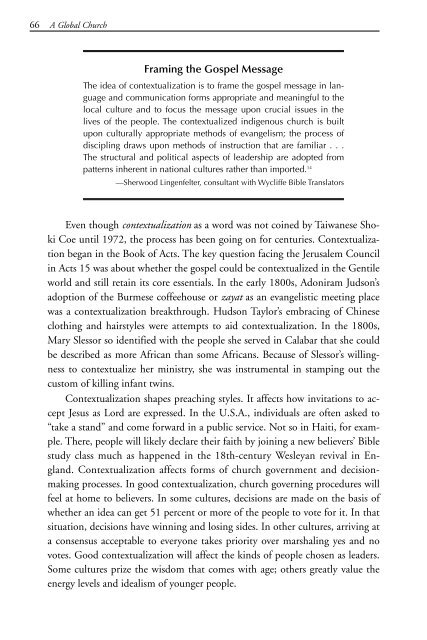discovering missions - Southern Nazarene University
discovering missions - Southern Nazarene University
discovering missions - Southern Nazarene University
You also want an ePaper? Increase the reach of your titles
YUMPU automatically turns print PDFs into web optimized ePapers that Google loves.
245187 Disc Missions ins 9/6/07 1:04 PM Page 66<br />
66 A Global Church<br />
Framing the Gospel Message<br />
The idea of contextualization is to frame the gospel message in language<br />
and communication forms appropriate and meaningful to the<br />
local culture and to focus the message upon crucial issues in the<br />
lives of the people. The contextualized indigenous church is built<br />
upon culturally appropriate methods of evangelism; the process of<br />
discipling draws upon methods of instruction that are familiar . . .<br />
The structural and political aspects of leadership are adopted from<br />
patterns inherent in national cultures rather than imported. 14<br />
—Sherwood Lingenfelter, consultant with Wycliffe Bible Translators<br />
Even though contextualization as a word was not coined by Taiwanese Shoki<br />
Coe until 1972, the process has been going on for centuries. Contextualization<br />
began in the Book of Acts. The key question facing the Jerusalem Council<br />
in Acts 15 was about whether the gospel could be contextualized in the Gentile<br />
world and still retain its core essentials. In the early 1800s, Adoniram Judson’s<br />
adoption of the Burmese coffeehouse or zayat as an evangelistic meeting place<br />
was a contextualization breakthrough. Hudson Taylor’s embracing of Chinese<br />
clothing and hairstyles were attempts to aid contextualization. In the 1800s,<br />
Mary Slessor so identified with the people she served in Calabar that she could<br />
be described as more African than some Africans. Because of Slessor’s willingness<br />
to contextualize her ministry, she was instrumental in stamping out the<br />
custom of killing infant twins.<br />
Contextualization shapes preaching styles. It affects how invitations to accept<br />
Jesus as Lord are expressed. In the U.S.A., individuals are often asked to<br />
“take a stand” and come forward in a public service. Not so in Haiti, for example.<br />
There, people will likely declare their faith by joining a new believers’ Bible<br />
study class much as happened in the 18th-century Wesleyan revival in England.<br />
Contextualization affects forms of church government and decisionmaking<br />
processes. In good contextualization, church governing procedures will<br />
feel at home to believers. In some cultures, decisions are made on the basis of<br />
whether an idea can get 51 percent or more of the people to vote for it. In that<br />
situation, decisions have winning and losing sides. In other cultures, arriving at<br />
a consensus acceptable to everyone takes priority over marshaling yes and no<br />
votes. Good contextualization will affect the kinds of people chosen as leaders.<br />
Some cultures prize the wisdom that comes with age; others greatly value the<br />
energy levels and idealism of younger people.

















